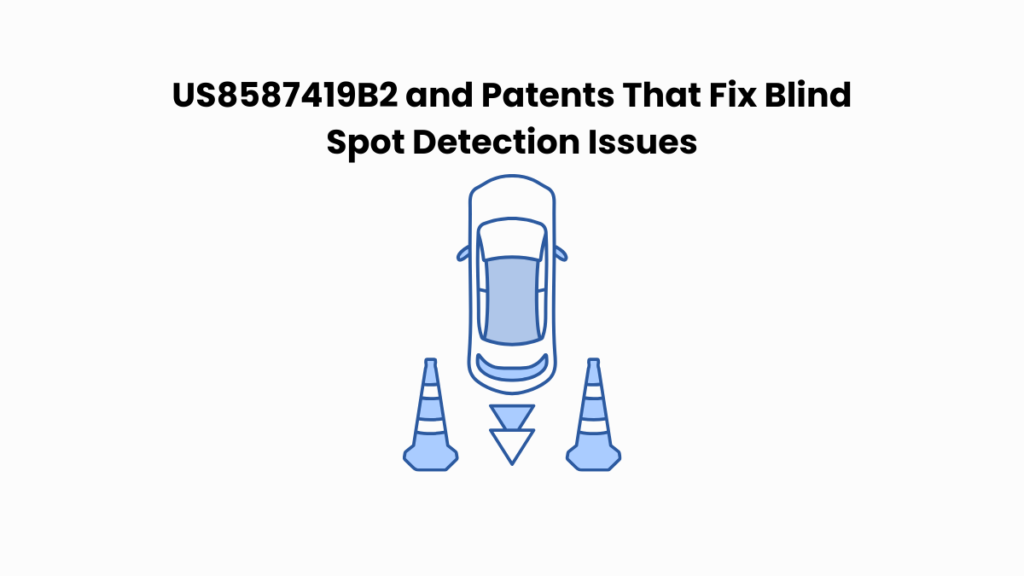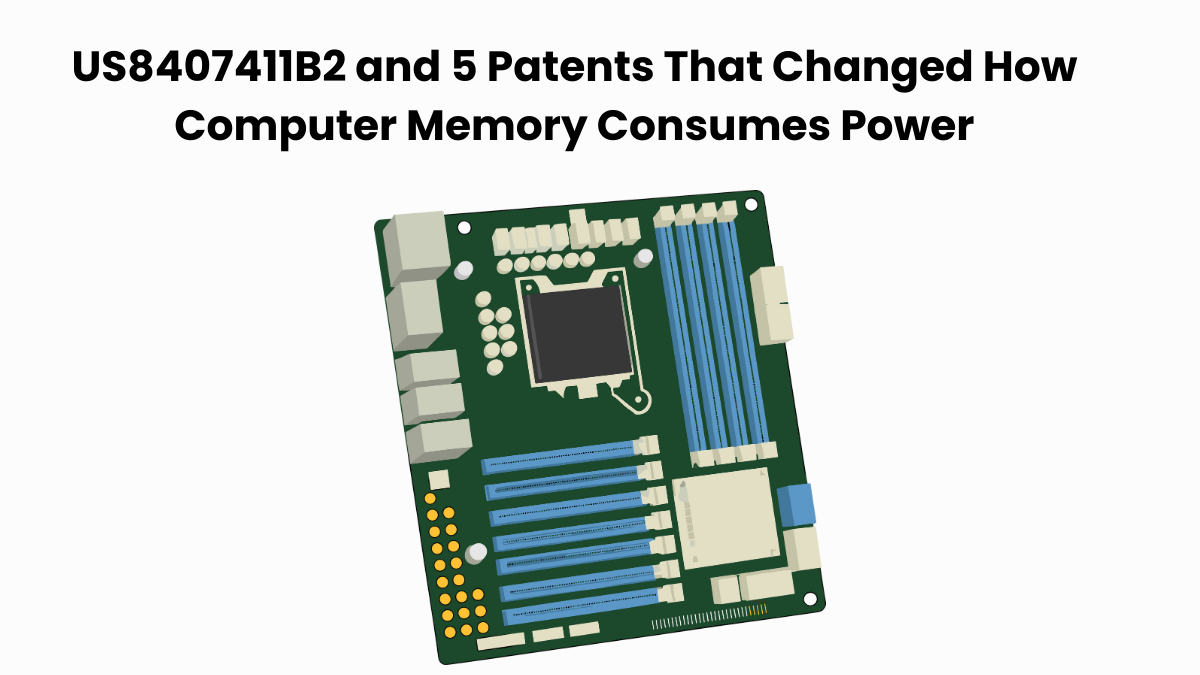Driving is about more than steering straight; it is about knowing what’s around you. Blind spots and hidden obstacles remain one of the biggest risks on the road, from backing into an unseen barrier to missing a cyclist riding alongside.
Patent US8587419B2 tackles this challenge with a smart detection system built into a vehicle’s body. Using sensors, such as video, radar, or sonar, it detects objects near the car and alerts drivers instantly through visual or audible signals. The goal is simple: faster awareness, fewer collisions.
This patent is currently involved in an infringement suit between Venegas and Volvo Car Corporation, but our focus here is the technology itself.
To see how the patent fits into decades of innovation in collision-avoidance systems, we used the Global Patent Search (GPS) tool to examine similar patents. From mirror-mounted sensors to bumper-based arrays, these filings demonstrate the range of approaches researchers have taken to reduce the severity of blind spots.
Understanding Patent US8587419B2
US8587419B2 discloses a vehicle-mounted detection system designed to help drivers identify nearby obstacles. The invention features a sensor housed within a medallion, which is mounted to a vertical surface on the vehicle, typically the front or rear.
The system can use various types of signal-generating detectors, including cameras, radar, or sonar. Once mounted, the detector captures information from its field of view and sends perceptible signals, such as visual displays or audible alerts, to assist with collision avoidance.
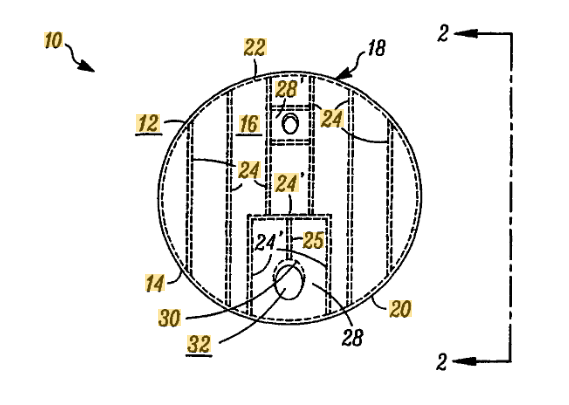
Source: Google Patents
The Key Features Of This Patent Are
1. A medallion housing affixed to the front or rear of a vehicle.
2. A detector cavity within the medallion formed by internal spacer ribs.
3. A signal-generating detector mounted at a precise angle (35–45 degrees) for optimal visibility.
4. An alignment wall and slot system to securely position the detector.
5. Support for multiple detector types: video cameras, radar, or active sonar.
6. Optional inclusion of a second detector with a different field of view or detection method.
7. A display interface that can be connected either by wire or wirelessly to show real-time signals.
8. Configurable outer medallion design that may include logos or surface ornamentation.
9. An inner and outer wall structure creating a protected housing volume.
10. Apertures that allow signal transmission and secure wiring or wireless communication.
This patent delivers a structured solution to enhance vehicle safety through embedded sensing hardware. By combining precise physical placement with versatile sensor options, it enables real-time detection of objects in critical blind spots. The design also ensures seamless integration into the vehicle’s body, supporting both function and aesthetics.
Related Read: Learn how US7609961B2 covers integrated vehicle cameras for blind spot monitoring, using visual data to enhance obstacle detection.
Similar Patents to US8587419B2
To better understand the technology landscape behind US8587419B2, we used the Global Patent Search platform to identify similar patents. These references reveal how various vehicle safety systems address the challenge of detecting obstacles near a vehicle’s blind zones.
They explore different sensor placements, alert mechanisms, and structural integrations that aim to reduce collisions. Below is a detailed look at five similar patents that share functional overlaps with US8587419B2. Let’s dig in.
1. EP0673802A1
This European patent, EP0673802A1, published in 1995, introduces a blind-spot monitoring system tailored for trucks. The invention integrates ultrasonic sensors into the side mirrors to detect nearby obstacles, especially vulnerable road users like cyclists and pedestrians. Once an object is detected, the system provides a visual or audio warning to the driver.
Below, we have added snapshots from the GPS tool displaying the relevant overlap from the specification of similar patents.
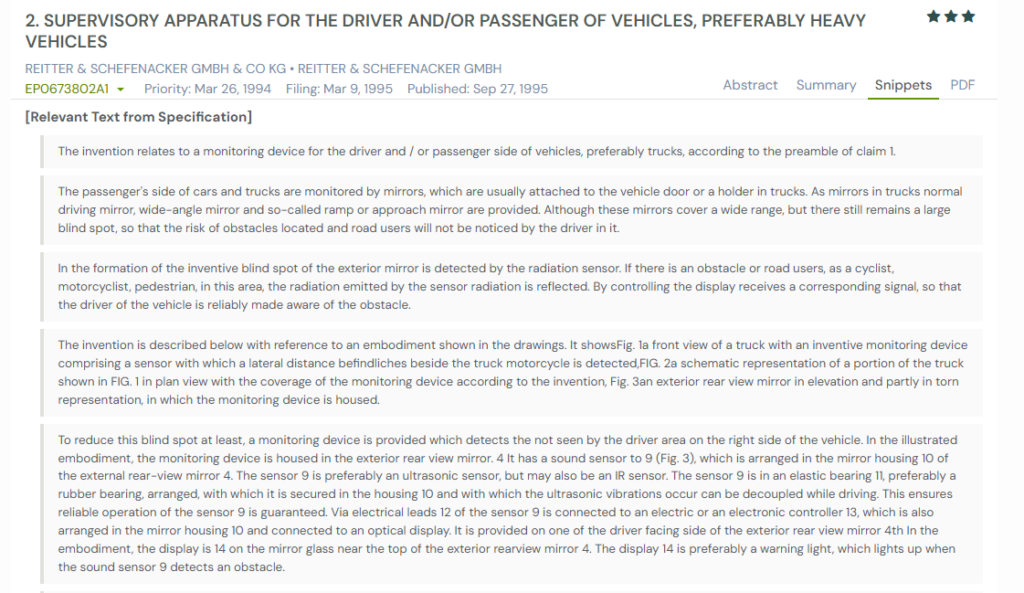
What This Patent Introduces To The Landscape
- A sensor-based monitoring device embedded in the exterior rear-view mirror
- Use of ultrasonic or infrared sensors to detect objects in blind spots
- Real-time detection of moving obstacles near the side of the vehicle
- A controller that processes sensor signals and activates a driver-facing visual or audio alert
- Placement of sensors in a vibration-isolated mount within the mirror housing
- A warning system that can be visual (LED light) or acoustic (sound alert)
- Optimized sensor angle to widen the detection area alongside the vehicle
- Detection range extending from the bumper backward and laterally up to 2.5 meters
- Mirror-based housing to integrate safety features without altering the vehicle structure
- Option for bilateral sensor placement to monitor both sides of the vehicle
How It Connects To US8587419B2
- Both patents focus on improving driver awareness using embedded object detection systems
- EP0673802A1 uses side-mounted sensors; US8587419B2 uses a medallion-mounted rear/front detector
- Each system relies on real-time sensing and perceptible driver alerts
- Both designs feature vibration-resistant sensor housings for accurate readings
- The goal in both inventions is to minimize blind spots and prevent collisions through integrated electronics
Why This Matters
This patent highlights how vehicle-mounted sensors can be seamlessly integrated into external parts like mirrors. Much like US8587419B2, it supports proactive obstacle detection using real-time feedback, helping drivers respond quickly to unseen hazards.
Related Read: Top Autonomous Vehicle Companies Redefining Transport in 2025
2. EP1878624A1
This European patent, EP1878624A1, published in 2008, introduces a modular object detection system for vehicles. Designed primarily for parking assistance and anti-break-in systems, it uses ultrasonic sensors mounted in the vehicle’s bumpers to detect nearby obstacles and transmit visual or audio alerts to the driver.
What This Patent Introduces To The Landscape
- A sensor-based system for detecting nearby objects, focused on parking and intrusion prevention
- Integration of ultrasonic sensors mounted on the front and rear bumpers
- Sensors transmit and receive echo signals to calculate the distance from surrounding objects
- Modular support structures for easy sensor installation and connection
- Direct wiring between sensors and the vehicle’s electronic control unit
- Real-time feedback delivered through a dashboard display or audio alert
- Improved wiring architecture for faster and more efficient installation
- Dual-sided sensor interfaces, external for detection, internal for electrical connection
- Visual or sound-based driver alerts for proximity warnings
- Support for multi-sensor configurations for broader coverage
How It Connects To US8587419B2
- Both systems aim to improve driver awareness by detecting nearby objects
- EP1878624A1 places sensors in bumpers; US8587419B2 uses a medallion housing
- Each invention uses ultrasonic signal transmission and echo detection
- Both transmit perceptible signals (visual or audio) to the vehicle’s operator
- The patents offer modularity for easier integration into the vehicle body
- Each approach supports multi-sensor use for broader spatial awareness
Why This Matters
This patent demonstrates how flexible sensor configurations can support advanced safety features in modern vehicles. Like US8587419B2, it focuses on detecting obstacles close to the vehicle, delivering real-time alerts through clean hardware integration.
A similar focus on capturing and interpreting real-time visual data appears in US8319619B2, which discloses how vehicle-mounted recording systems process motion and scene changes to improve driver awareness.
3. DE2312248A1
This German patent, DE2312248A1, published in 1974, introduces an early rear-collision prevention system for vehicles. It uses sonar-based transmitters and receivers mounted at the rear to detect obstacles during reversing and alerts the driver via visual or acoustic signals.
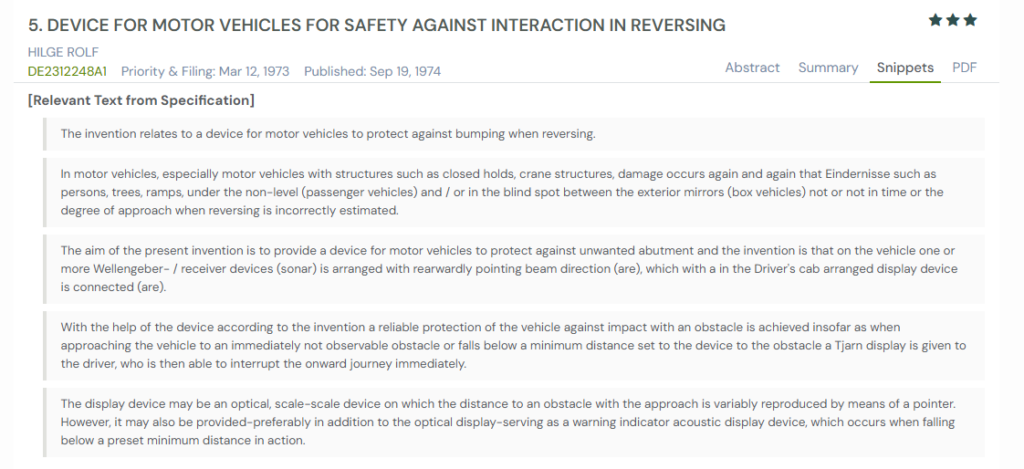
What This Patent Introduces To The Landscape
- A sonar-based object detection system for vehicle reversing safety
- Rear-facing sonar transmitters and receivers mounted on the vehicle
- Real-time obstacle detection behind the vehicle
- A driver-facing display unit installed inside the vehicle cabin
- Visual indicators using a pointer to represent varying distances
- The optional acoustic warning device is activated when the minimum distance is breached.
- A system that warns the driver before a potential rear collision
- Suitable for vehicles with blind spots, such as box trucks and vans
- Designed to detect both stationary and moving obstacles
- Focused on reducing reversing accidents due to poor rear visibility
How It Connects To US8587419B2
- Both patents aim to prevent vehicle collisions using rear-facing detection systems.
- DE2312248A1 uses sonar transmitters; US8587419B2 supports sonar, radar, and video detectors
- Each system delivers perceptible warnings to the driver, visually and/or audibly.
- Both inventions improve safety in scenarios where rear visibility is limited.
- They rely on sensor positioning and signal processing to measure proximity to obstacles.
Why This Matters
This patent shows that rear-collision avoidance has long been a challenge in automotive design. Like US8587419B2, it offers an embedded sensing solution with direct driver feedback, reinforcing the need for proactive obstacle detection in blind zones.
A similar emphasis on integrating safety hardware into a vehicle’s exterior without disrupting its structure appears in US9050929B2, which focuses on protected, weather-resistant lighting systems.
4. US2007182527A1
This U.S. patent, US2007182527A1, published in 2007, introduces an advanced collision avoidance display system for heavy vehicles. The invention uses proximity sensors and patterned visual indicators to show drivers the real-time position and movement of multiple objects around the vehicle.
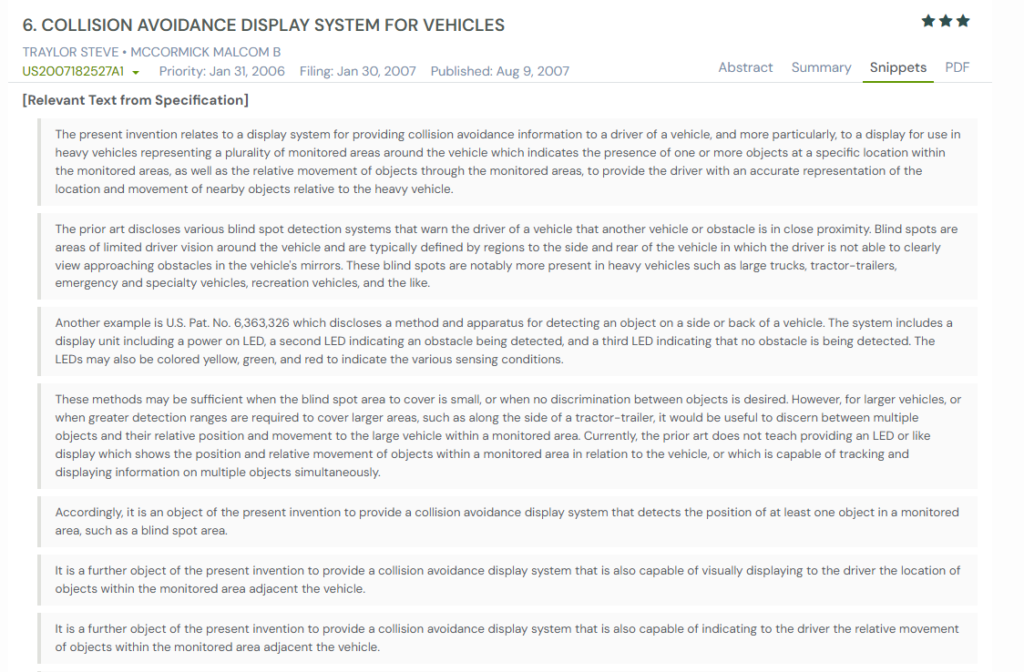
What This Patent Introduces To The Landscape
- A collision avoidance system designed for blind spot coverage in large vehicles
- Proximity sensors that detect objects in front, back, and on both sides of the vehicle
- A detector display showing object location using illuminated zones and indicators
- Real-time visual feedback on object presence and relative movement
- Sensor coverage defined by light beam arrays (infrared or other technologies)
- A display embedded in or near the rear-view mirror housing for constant visibility
- Visual indicators aligned to the vehicle’s physical geometry for intuitive awareness
- Support for multiple monitoring zones around the entire vehicle perimeter
- Integration with various light technologies, including LEDs, EL panels, or LCDs
- A beam controller managing signal processing and object tracking across all sensors
How It Connects To US8587419B2
- Both systems aim to provide real-time awareness of objects surrounding a vehicle
- US2007182527A1 uses advanced displays to show object position and motion; US8587419B2 uses alert signals
- Each system integrates sensors mounted in or on exterior vehicle components
- Both designs enhance driver awareness through perceptible visual and/or audio cues
- They offer structured hardware placement to cover blind spots effectively
- Each patent supports multi-sensor use for wider detection coverage
Why This Matters
This patent emphasizes multi-zone object tracking and driver-friendly visualization. Like US8587419B2, it reflects how embedded sensors and intelligent displays can reduce collision risk, especially in areas not easily visible with mirrors alone.
5. WO9834131A1
This international patent, WO9834131A1, published in 1998, introduces a simplified and interference-resistant blind spot warning system. The invention uses modulated radiation beams and position-sensitive detectors to alert drivers when other vehicles enter a predefined danger zone.
What This Patent Introduces To The Landscape
- A warning system for vehicles to monitor diagonal rear blind spots
- Use of modulated radiation beams and position-sensitive detectors for accurate object detection
- A detection zone defined by overlapping radiation beams
- Visual alerts, such as flashing lights, are triggered when objects enter the defined detection area
- The system minimizes false alarms by requiring simultaneous reflection from two beams
- Configurable detection angles to optimize sensitivity and coverage
- Integration options on or near the vehicle’s rear-view mirrors
- Visual indicators positioned near the mirror or inside the vehicle cabin
- Optional use of audio signals alongside visual alerts
- Additional utility for reversing scenarios and distance warnings in poor visibility
How It Connects To US8587419B2
- Both patents focus on driver alert systems for obstacles in blind or hard-to-see areas
- WO9834131A1 uses radiation-based detection; US8587419B2 supports radar, sonar, or video sensors
- Each system sends a perceptible signal (visual and/or audible) to inform the driver
- Both designs aim for minimal interference and reliable function across different environments
- Each invention can be integrated with or mounted onto existing vehicle hardware.
Why This Matters
This patent underscores the value of simple, cost-effective detection systems that function reliably in real-world conditions. Like US8587419B2, it targets blind spots and emphasizes strong signal accuracy, making it a relevant and practical addition to the collision avoidance landscape.
Related Read: See how US7714726B2 and similar patents focus on minimizing signal interference in RFID-based detection systems. This aligns with the above-mentioned patents, which also rely on reliable signal transmission for effective obstacle recognition near vehicles.
How to Find Similar Patents Using Global Patent Search
When evaluating collision detection technologies like US8587419B2, it is important to explore similar patents that tackle related safety challenges. The Global Patent Search platform simplifies this process by highlighting patents focused on proximity sensors, rearview monitoring systems, and integrated vehicle alert displays.

Here’s how to use GPS to uncover key similarities in the patent landscape:
- Start with the core reference: Input US8587419B2 into the GPS search tool. You can refine results using terms like “rear-mounted sensor,” “vehicle medallion,” or “blind spot monitoring.”
- Scan GPS snippets: These short, curated excerpts allow you to quickly recognize shared claim elements, such as angular detector placement, display feedback methods, and multi-sensor configurations.
- Compare detection strategies: Many similar patents use ultrasonic, radar, or camera systems, just like US8587419B2, to identify obstacles and trigger visual or audible alerts. Reviewing how each patent structures its feedback loop can reveal overlapping or diverging approaches. You can also sort by relevance feature to get prior art close to your needs.
- Gain cross-industry perspective: Whether you are developing smart vehicle safety systems or refining proximity detection technologies, GPS helps uncover similar patents, even those emerging from other areas of intelligent mobility and sensor-based automation.
Global Patent Search gives innovators, legal teams, and product strategists a deeper understanding of how similar solutions are being protected and challenged. By analyzing comparable technologies and their legal status, you can make more confident decisions around design, differentiation, and patent strategies. Try the tool today!
Disclaimer: The information provided in this article is for informational purposes only and should not be considered legal advice. The related patent references mentioned are preliminary results from the Global Patent Search tool and do not guarantee legal significance. For a comprehensive related patent analysis, we recommend conducting a detailed search using GPS or consulting a patent attorney.

